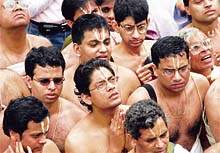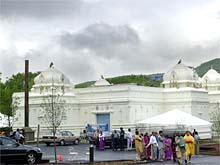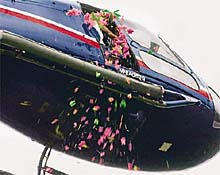
May 28, 2001
Holy Men (and a Cow) Consecrate Hindu Temple
By SHAILA K. DEWAN
| |||||
| |||||
|
 OMONA, N.Y., May 27 — Everyone crowded onto the fresh black asphalt and stood looking up at the gods. There they were, monkey gods and winged gods, sleeping gods and praying gods, posed around the ornate onion- domed towers of the Sri Ranganatha Temple, awaiting consecration.
OMONA, N.Y., May 27 — Everyone crowded onto the fresh black asphalt and stood looking up at the gods. There they were, monkey gods and winged gods, sleeping gods and praying gods, posed around the ornate onion- domed towers of the Sri Ranganatha Temple, awaiting consecration.
But how to attain the heavens?
Today, the eight priests who had traveled from India for the opening of the temple in Rockland County, their bare chests and foreheads painted with a fierce symbol of "the footprint of God," ascended in a Genie TMZ-34/19 cherry picker. The helicopter was delayed by fog.
The temple is too new to have been landscaped, so a sea of sticky mud separated it from the hundreds of devotees, women in bright saris trimmed with gold, children in embroidered shifts, and men who simply wore dhotis, long pieces of white cloth fashioned into loose pants. But they did not hesitate to squish through it, barefoot, for a chance to be sprayed with saffron-scented holy water from the priests above.
One person opted out of the holy shower: Kimberley Camburn, who had brought her Holstein cow, Hope, from nearby Stormville early in the morning, and watched as Hindu women, many of them more at home in front of a computer than an udder, milked her in the temple.
Some celebrants came from the nearby towns of Spring Valley, West Nyack and White Plains for the camaraderie and pomp of the opening, which ended today after a week of ceremonies and performances. The Hindu temple, many in attendance said, is the first in Rockland County, where Asians have increased by 50 percent since 1990, according to the 2000 census.
Trustees said 10 families took out second mortgages on their homes to help finance the $2.2 million temple, whose 6,500-square-foot sanctuary held a sea of people today who sat elbow to elbow on thin rugs, chanting for hours and reaching out to touch a camphor-scented flame that was carried about the room.
"It's a very auspicious occasion, the beginning of the temple," said Bhakti Vijnana Swami, a computer consultant from Jamaica, Queens, as he made his way past the embers of four ritual fires that had been set outside the temple. "It's purifying but also satisfying."
The temple also drew guests from places like Texas, Mississippi, Alabama and Massachusetts, who came because Sri Ranganatha is said to be the first temple in the country devoted to Sri Vaishnavaism, a strain of Hinduism that is devoted to the god Vishnu and his many incarnations and has its roots in southern India.
Sri Vaishnavaites maintain that one can reach enlightenment but still retain a separate identity, albeit one whose purpose is to serve God. Initiates are lightly branded with the symbol of the discus and the conch shell, one on each shoulder. The women wrap their saris in a distinctive fashion, and the men wear dhotis at religious functions.
"I never thought when I came here in 1973 that I would see a temple this authentic and of this grandeur, following this very prescribed way," said Nagu Satyan, explaining that it was built according to the Vedas, or Hindu scriptures. Ms. Satyan, a senior manager at a defense company who lives in Littleton, Colo., said she was happy at last to have a place of worship dedicated to the one god that Sri Vaishnavaites like her believe in, rather than the multitude of deities to be found in typical temples. "Most temples in the U.S.A. sort of modify to appeal to more people," she said.
For non-Sri Vaishnavaites, attending the temple is something akin to Lutherans' attending a Methodist church, some of them said. They said they did not mind, and were just happy to have a place to worship.
"We get a sense of belonging, putting down roots," said Aruna Bharati, who has lived in the area for almost 23 years and who said she had been a member of a group that tried to open a temple before there were enough Indians to sustain one. "If you have no temple in the community, you feel rootless."
The Sri Ranganatha Temple was a long time coming. Fourteen years ago, a Sri Vaishnavaite teacher in India asked one of his students, a Pomona physicist named Venkat Kanumalla, to build a temple in America. Dr. Kanumalla, who is also a Sri Ranganatha priest, began to raise money by performing what he estimates amounted to 600 religious ceremonies, or pujas, in people's homes all over the country.
This afternoon he emerged after hours in the temple's inner sanctum, where he had been attending to a granite Vishnu reclining on a coiled, five-headed cobra, sheltered by its hoods. He looked as drained and blissful as a victorious athlete. His "footprint of God" had faded from sweat, his foot was smudged with yellow powder, and he carried a wilting garland under one arm.
Eight years ago, he said, he bought acres in Ladentown, a hamlet Ladentown that straddles Pomona and Ramapo. But then, he said, he had to work to quell fears among local Indian-Americans that the temple would exclude those who were not Sri Vaishnavaites. And a neighborhood group sued to prevent construction.
Finally, in 1997, a construction permit was granted. And today the conflicts over the temple's construction seemed well in the past. "I've been in this country a long time," said Ms. Bharati, the temple trustee, with no particular rancor. "If people don't know what it is, they're afraid of it. They didn't know what to expect. If it was just a church, I don't think we would have that problem, because people know what a church is."
But Ian Banks, who lives next door to the temple and is a Pomona trustee and past president of the Ladentown Preservation League, said the concerns had more to do with the size of the temple, which he said had been larger in the original plans, and its effect on traffic, noise and the neighborhood's rural character. "They try to turn it into some kind of anti- religious thing, but it's not," he said.
From Mr. Banks's shady backyard, where he spent the day replacing the shingles on his old clapboard farmhouse, the temple presented a striking contrast to the red barn and humble woodshed. Where horses once grazed, fuchsia banners fluttered, anchored to golden balls that crowned elaborate turrets.
And then, as Mr. Banks looked on, a stiff wind bent the trees in his yard and caused the women on the temple driveway to clutch at their saris. The helicopter, five hours late, arrived and opened a hatch, depositing a heavy rain of multicolored flowers onto the expectant crowd.


